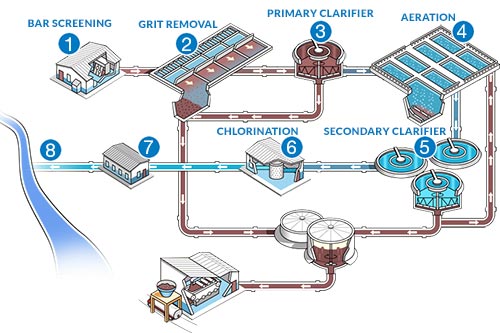Ways to Reduce Environmental Impact with Proper Wastewater Disposal
Ways to Reduce Environmental Impact with Proper Wastewater Disposal
Blog Article
Recognizing Wastewater Treatment Processes and Their Ecological Impact
The complexities of wastewater therapy processes play an essential role in mitigating ecological obstacles related to water air pollution. Each stage, from preliminary to innovative therapies, is created to attend to particular contaminants, eventually safeguarding both public health and wellness and water environments. Regardless of technical advancements in treatment effectiveness, considerable obstacles linger, consisting of the management of recurring toxins and the implications of nutrient runoff. As we explore the complexities of these processes, it ends up being crucial to wonder about just how much existing methodologies can develop to meet the growing demands of sustainability and environmental preservation.
Summary of Wastewater Treatment
How is wastewater transformed right into a secure resource for the environment? Wastewater therapy is a crucial procedure made to get rid of pollutants from used water, thereby guarding public health and wellness and safeguarding communities. This procedure starts with the collection of wastewater from domestic, industrial, and business sources, which is after that guided to treatment centers.
At these facilities, numerous physical, chemical, and biological techniques are employed to treat the wastewater. Ultimately, biological therapies, such as turned on sludge procedures, utilize bacteria to break down organic matter.
The dealt with effluent can be safely released into all-natural water bodies or recycled for irrigation and commercial objectives, promoting resource preservation. Additionally, the treatment procedure produces biosolids, which can be repurposed as plant foods or dirt amendments, additionally boosting sustainability.
Stages of Treatment Procedures
The wastewater therapy process typically consists of 3 key stages: preliminary, main, and second therapy. Each phase serves an unique function in lowering the pollutant load and making certain the effluent fulfills environmental criteria before discharge.

The key therapy phase concentrates on the physical splitting up of put on hold solids from the wastewater. With sedimentation, much heavier bits resolve at the base of sedimentation tanks, forming sludge, while lighter materials, such as oils and greases, float to the surface and are skimmed. This procedure significantly lowers the organic and not natural lots in the wastewater.
Second therapy is a biological procedure intended at further lowering the concentration of organic issue. This phase is essential for attaining the necessary biochemical oxygen need (FIGURE) decrease, eventually leading to cleaner effluent ready for discharge or further therapy.

Advanced Treatment Technologies
Adhering to the secondary treatment procedures, advanced therapy modern technologies play an essential function in further boosting the top quality of dealt with wastewater. These technologies are made to get rid of residual contaminants that are not efficiently removed during primary and second treatments, making certain the effluent satisfies strict governing criteria.
Among the extensively used innovative treatment methods are membrane purification, reverse osmosis, and progressed oxidation processes. Membrane filtering, including microfiltration and ultrafiltration, is efficient in dividing great particles, pathogens, and colloids from the water (Wastewater). Reverse osmosis uses semi-permeable membranes to get rid of liquified solids, resulting in top notch water suitable for different applications
Advanced oxidation processes (AOPs) use strong oxidants to deteriorate organic contaminants, including drugs and individual care items that are immune to conventional treatment. These techniques improve the biodegradability of intricate substances, promoting their removal.
One more considerable technology is making use of biological nutrient elimination procedures, which specifically target nitrogen and phosphorus, preventing eutrophication in getting water bodies. On the whole, advanced treatment technologies are essential for accomplishing greater levels of filtration, promoting water reuse, and guarding public health and wellness while attending to the obstacles connected with wastewater Clicking Here management.
Ecological Advantages of Therapy
Countless environmental advantages develop from efficient wastewater treatment procedures that contribute to ecosystem wellness and sustainability. pop over here Mainly, these procedures considerably minimize the launch of hazardous toxins right into all-natural water bodies, which helps preserve marine ecosystems. By eliminating contaminants such as hefty steels, nutrients, and microorganisms, treated wastewater minimizes the risk of waterborne illness and advertises biodiversity in marine atmospheres.
Furthermore, wastewater treatment facilities often utilize sophisticated technologies that make it possible for water recycling and reuse. This method not only preserves freshwater resources but additionally lowers the need on all-natural water products. Improved nutrient elimination from wastewater can likewise stop eutrophication, a process that causes algal blooms and subsequent oxygen deficiency in aquatic systems.
Furthermore, efficient therapy processes can decrease greenhouse gas discharges, particularly methane and laughing gas, which are commonly launched during without treatment wastewater disintegration. By catching and making use of biogas from anaerobic digesters, facilities can convert waste right into renewable resource, thus adding to a reduction in fossil fuel reliance.
Difficulties and Future Patterns
While the environmental advantages of wastewater treatment are clear, a number of difficulties linger that impede ideal results in this field. One visit here major problem is aging facilities, which commonly causes ineffectiveness and raised operational prices - Wastewater. Several therapy plants were developed decades ago, and their abilities do not line up with contemporary needs, that include stricter governing standards and greater volumes of wastewater due to urbanization

Looking in advance, there is an expanding focus on resource recovery and round economic climate concepts within wastewater treatment. Innovations such as anaerobic food digestion, which can produce biogas, and progressed purification technologies are acquiring traction. These techniques not only enhance therapy efficiency however additionally promote sustainability.
Eventually, resolving these difficulties needs collaboration among stakeholders, investment in innovation, and a commitment to continuous research. By embracing these fads, the wastewater treatment market can evolve to satisfy the demands of a changing atmosphere and culture.
Verdict
In verdict, wastewater treatment procedures play an important duty in enhancing environmental top quality and public health. The multi-stage therapy framework, coupled with sophisticated innovations, effectively mitigates contamination and advertises lasting water administration.
Report this page